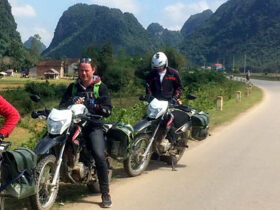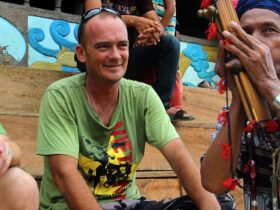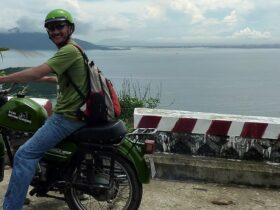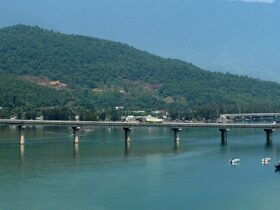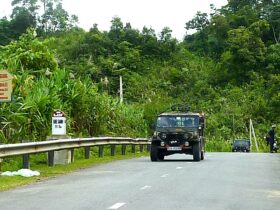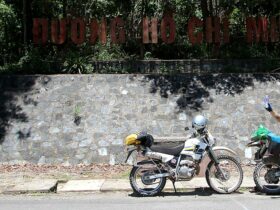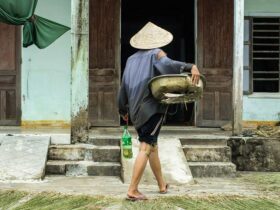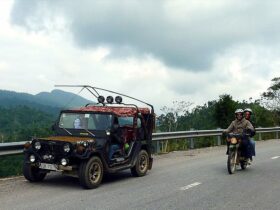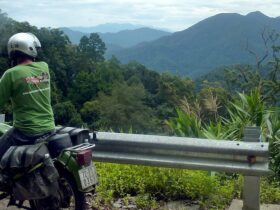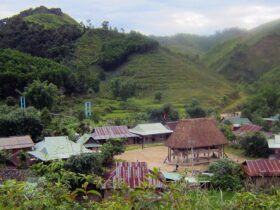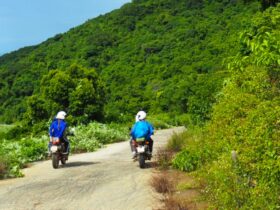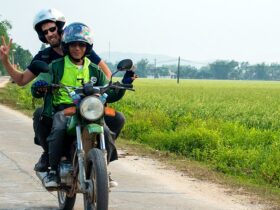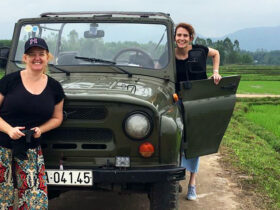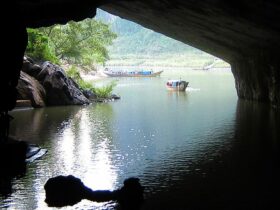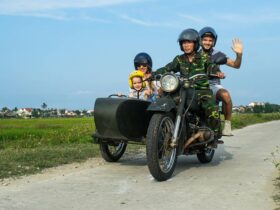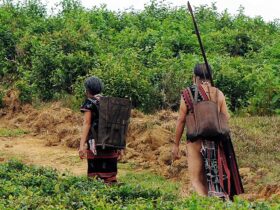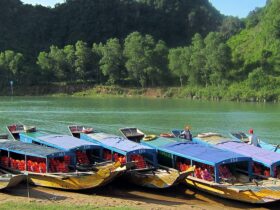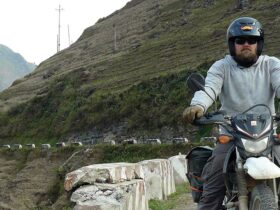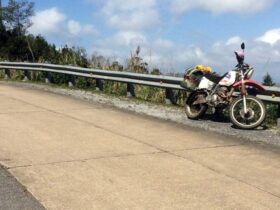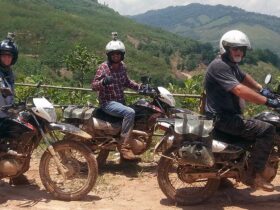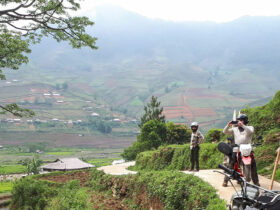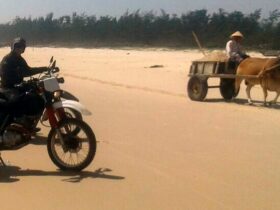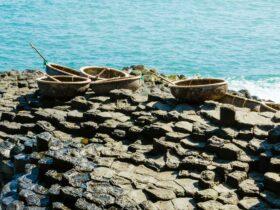see the real vietnam on a motorcycle tour
Those looking for a memorable Asian holiday experience need look no further than Vietnam. A destination made famous by its tumultuous history, amazingly varied landscapes, incredible food and beautiful people. Our Vietnam motorcycle tours have been operating for over 10 years now. During this time we have explored the length and breadth of the country, going places largely left untouched by tourism. We are constantly looking for new exciting roads to ride, finding the less travelled areas to take you away from the tourist crowds. For those looking for a true Asia adventure, who want to see the real Vietnam, the motorcycle tours are just the experience for you. No matter if you would like to ride the motorbike yourself, or marvel at the landscape from the passenger seat of a jeep, we have just the tour for you. A word of warning though, once you have tasted what rural Vietnam has to offer you will want to come back, again and again, and again.
Motorcycle Riding in Central Vietnam
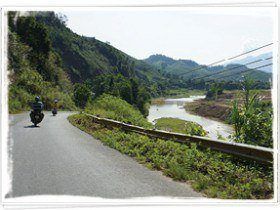
Hoi An Motorbike Adventures is based in Hoi An, the ancient port of Central Vietnam. Famous for its laid-back lifestyle, tailors, and food culture, this lovely old town is ideally positioned as a gateway into Central Vietnam.
The sheer variety of landscapes is truly mind-boggling. A one day tour can see you driving through paddy filled coastal floodplains one minute and mountainous rainforests the next. In addition to the natural wonders of this country, the rich cultural history of Central Vietnam provides a large number of man-made wonders to fill your eyes. From a humble farming hamlet to decaying battle sites and ancient ruins that have stood silent and strong throughout the ages.
when to ride
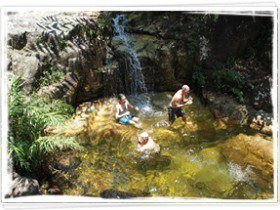
The weather in Central Vietnam can be a temperamental beast and you can expect varying amounts of rain and sunshine throughout the year, especially in the highlands.
Having said that though, probably the best time to travel to Hoi An, Hue and their surrounds is between the months of mid-January and late-August. During this time the weather tends to be quite dry and the temperatures average in the early 30s. The wet season rolls in late September and generally the months of October through to mid-December are rather damp with lowland flooding not uncommon.
Temperatures can get quite chilly in late December and early January so if you’re planning to travel or come on a Motorcycle Tour with us then, make sure you pack a few warm clothes. Mid-April to end of July are usually the hottest months with temperatures reaching the 40s. Occasional thunderstorms are common in the afternoon.
highlights
With 54 ethnic minorities and a history that span millennia, the people of Vietnam have a unique perspective on life and would love to share it with you. HAMA takes you to them.
From its beautiful coastline to the rugged interior, the sheer variety of landscapes in Vietnam will leave you thirsting for more and more. HAMA delivers it to you on a plate.
The war lasted a decade and left numerous scars on the Vietnamese countryside. Many have been redeveloped, some have been forgotten. HAMA have found the hidden gems.
It is only relatively recently that many of Vietnam’s ethnic minorities have been accessible to the outside world. Sample their culture and way of life. HAMA is a part of their community.
Made famous as the lifeline for Communist forces during the American War, the Ho Chi Minh Trail is one of the greatest roads for riding motorbikes on earth. HAMA knows it like no others.
places we go
hoi an
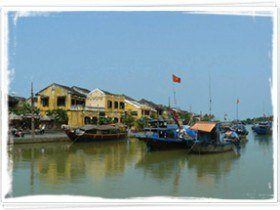
Hoi An has been an important port since the 15th century when traders from China, Japan, India, and Holland established shop houses on the banks of the Thu Bon river. The influence of these traders, and the French colonialists who followed, is still evident in the town’s architecture, cuisine and the importance of the river in the lives of local residents.
The town’s famous covered bridge was built by Japanese traders, who believed its construction would slay a dragon that had its head in India, heart in Hoi An and its tail in Japan, and was responsible for earthquakes in Japan.
As the Thu Bon River began to silt up in the 19th century, the port was gradually overshadowed by nearby Da Nang. The town miraculously survived the ravages of the American War, and its remarkably preserved shop houses were declared as a UNESCO World Heritage site in 1999.
The town is attracting travelers from around the world, who are drawn to the town’s famous architecture, fine dining and high-class tailors.
my son
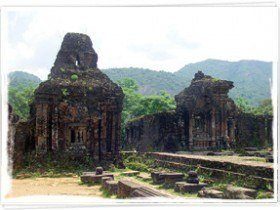
My Son is a Hindu temple complex, located in the village of Duy Phú, in the administrative district of Duy Xuyên in Quang Nam province in Central Vietnam, 69km southwest of Da Nang, and approximately 10 km from the historic town of Tra Kieu. It comprises many Champa temples, in a valley roughly two kilometres wide, surrounded by two mountain ranges.
It was the site of religious ceremonies for the Kings of the empire of Champa, and was also a burial place of Cham royals and national heroes. The My Son temple complex is one of the foremost temple complexes for Hinduism in South East Asia and is the premier heritage site of this type in Vietnam.
son tra
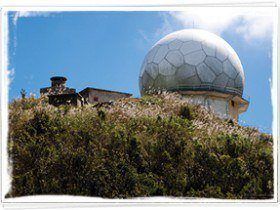
Raising 693m out of the Eastern sea and covered with pristine rainforest, Son Tra Peninsula, or Monkey Mountain as it is also known brings natural beauty right to Da Nang’s doorstep. This largely undeveloped stretch of land was until quite recently solely the domain of the Vietnamese military due to its strategic value as the guardian of Da Nang harbor.
With its pristine natural beauty and varied fauna and flora, Son Tra is a delight to ride around. The sweeping and sometimes quite steep roads will see you riding higher than Hai Van Pass with the chance to glimpse rare monkeys and the certainty of seeing old growth forest. This highly panoramic road also passes highly significant American War era sites and the largest female Budha in Vietnam at the impressive Linh Ứng pagoda.
hai van pass
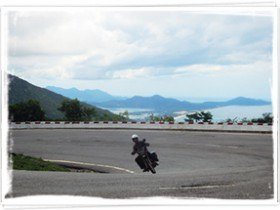
Just to the North of Da Nang and on the way to the ancient capital of Hue lies the infamous Hai Van Pass. The opening of the tunnel in 2005 has seen this winding road change from a motorbike riders nightmare into a riders dream, with all bar a few cars and trucks now taking the subterranean route. The view from the top is spectacular and an old French come American fort stands in silent witness to the pass’s important military history.
In 2008, the boys from Top Gear made this pass even more famous when they crossed over it in their Vietnam special. Richard Hammond’s choice of motorbike, one of Hoi An Motorbike Adventure’s Minsks served him well and lapped up the road with aplomb.
marble mountain
Between our base in Hoi An and the booming port city of Danang lies Marble Mountain and My Khe Beach. Known to the Vietnamese as Non Nuoc, which literally means “Our Country”, it was nicknamed China Beach by American GIs on R&R. This long stretch of beach offers views to the mountainous headlands North of Danang and the Cham Islands to the east. Just behind the beach, five rocky outcrops known as Marble Mountain have long been sacred to the Vietnamese and still serve as Buddhist temples.
bho hoong
Nestled in the Truong Son mountain range and sitting astride the beautiful Kon River is the land named Bho Hoong. In the 1970’s as the American war was finishing an ethnic minority, the Co Tu, moved their people from the devastated highlands near the Laos border to this promising new location. Within a few years a traditional ethnic minority village, bearing the land’s name, came in to existence and blends in with the rugged landscape with an ease only true mountain people can muster.
Fast forward 30 or so years and now stands a village of just 315 souls whose lives are ruled by the seasons just as they have been for time immemorial. Traditional agriculture, especially the cultivation of sticky rice and vegetables dominate local life. The ancient practice of weaving can be seen everywhere, from the sturdy yet decorative clothing to buildings woven in a way that resists the very elements themselves. The largest and most decorative of these are the Guol and Moong houses. In the middle of the village common a totem pole stands as a silent witness to harvest festivals, marriages and funerals.
Those wishing for a taste of ethnic minority life in Vietnam are now welcome with the village opening its doors to intrepid travellers in 2013. A selection of stilted wood and rattan bungalows have been modernised to provide a comfortable experience and numerous traditional activities made available for those wishing for a unique getaway.
hue
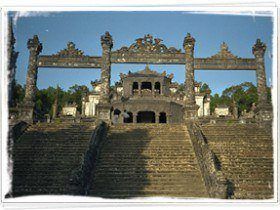
Hue originally rose to prominence as the capital of the Nguyen Lords, a feudal dynasty which dominated much of southern Vietnam from the 17th to the 19th century. In 1775 when Trinh Sam captured it, it was known as Phú Xuân. In 1802, Nguyễn Phúc Ánh (later Emperor Gia Long) succeeded in establishing his control over the whole of Vietnam, thereby making Huế the national capital.
Huế continued to be the capital until 1945, when Emperor Bảo Đại abdicated and a Communist government was established in Hà Nội (Hanoi), in the north. While Bảo Đại was briefly proclaimed “Head of State” with the help of the returning French colonialists in 1949 (although not with recognition from the Communists and the full acceptance of the Vietnamese people), his new capital was Sài Gòn (Saigon), in the south.
In the Vietnam War, Huế’s central position placed it very near the border between North Vietnam and South Vietnam. The city was located in the South. In the Tết Offensive of 1968, during the Battle of Hue, the city suffered considerable damage not only to its physical features but its reputation as well, most of it from American firepower and bombings on the historical buildings as well as the now infamous massacre at Huế committed by the Communist forces. After the war’s conclusion, many of the historic features of Huế were neglected, being seen by the victorious regime and some other Vietnamese as “relics from the feudal regime”, but there has since been a change of policy, and some parts of the historic city have been restored.
Khe Sanh
Khe Sanh is close to the Laos border and as such has the feel of a border crossing town. Bustling markets and thriving noodle shops make for a hectic scene each morning, though Khe Sanh is on the map because of the siege lasting 75 days in 1968 between the USA and the NVA in 1968 as well as its location within the demilitarised zone. The base was never overrun by the NVA though the battle was the most bloody for the Americans during the war and world-wide media coverage resulted in calls to end the American involvement to fever pitch. We visit the base, where today you wind find a museum and the landing strip adorned with various warplanes and other remnants from war time. The areas in and around Khe Sanh contain many sites of significance during the war (though many have decayed over time). A super cool and interesting place to visit by motorbike.
Phong Nha
Phong Nha is a sleepy little town with absolutely stunning scenery all around. Famous for its caves and declared a UNESCO world heritage site in 2003, the town has seen a lot of change. It’s still sleepy and rural, though it now has an ATM and you can get pizza! The highlight however is the Phong Nha Khe Bang National Park, home to thousands of limestone caves (many yet to be discovered). The caves are the oldest in Asia, and archaeologists have dated them at around 400 million years old. The park is still tightly controlled by the military who closely guard access. The water in the rivers around the caves is so blue it’s scary and the caves are absolutely breathtaking in size and magnitude.
Browse all our Central Vietnam Motorcycle Tours
Motorcycle Riding in North Vietnam
The rugged north of Vietnam is a land full of mountains, rice paddies and remote villages, far removed from the bustling city life of Da Nang or Hoi Chi Minh City and cherished by biker communities all over the world. Places like Sapa, Dien Bien Phu, Dong Van and Ha Giang offer stunning green views for miles into the distance whilst the villagers come from ethnic minority groups that reveal the diversity of Vietnamese culture.
when to ride
North Vietnam has a reputation for being cold compared to the rest of the country. And being largely located in the mountainous regions this is what you would expect. However, whilst it is cooler than the rest of the country during the monsoon season of November to March, it is certainly warmer than many places in Europe at this time and during the warm-hot months of April to October, you can expect to see temperatures as high as 35 degrees.
Places we go
Sapa
This popular tourist town is particularly noted for being home to ethnic minorities such as Hmong, Dao (Yao), Giáy, Pho Lu and Tay as well as for its lush green terraces which roll effortlessly down the hills like a carpet. The cable car to the peak of Mt Fansipan, the so-called ‘roof of Indochina’, is a must-see attraction.
Ha Giang
This trading post on the banks of the river Lo and near the Chinese border is steeped in history and culture and is perhaps best known for being the starting point of the famous motorbike loop named after it, one of the most spectacular in the country.
Dong Van
Another town close the Chinese border, Dong Van town is worth visiting for its UNESCO listed geopark. Located between 1400 to 1600 eters above sea level, you will encounter spectacular views from your motorbike, high up in the clouds. With 17 different ethnic groups living in this area, you are bound to have a truly local experience as you learn about unique cultures from the villagers.
Dien Bien Phu
The historical significance of Dien Bien Phu City in the north-west of Vietnam cannot be overstated. It was here where the French onceded defeat and French rule over Indochina came to an end in 1954.
Mai Chau
Situated 150km from Hanoi, Mai Chau is a pastoral paradise. For miles into the distance all you can see is green between either side of the two giant cliffs that enclose the province. The ethnic Thai villages reveal a less-travelled side of Vietnam that feels utterly disconnected from the rest of the country, indeed the world; it is hard to imagine that in a mere few hours you can be back in the bustling chaos of the city.
Ba Be Lake
Situated around halfway between Hanoi and Ha Giang, Ba Be is the largest natural lake in Vietnam and of the biggest freshwater lakes in the world. The lake was formed around 200 million years ago and is enclosed by limestone cliffs and lush green forests.
Browse all our North Vietnam Motorcycle Tours
Motorcycle Riding in South Vietnam
If the north of Vietnam is about the mountainous life then the south is more about beaches and sleepy fishing villages by the coast.
The ever-expanding Ho Chi Minh City, once the capital of former South Vietnam, is the bustling heart of the south. It just a few hours ride to the laid back town of Mui Ne. From here you can ride up into the mountains until you reach Da Lat – very much the pride and joy of Vietnamese locals who like to honeymoon here. Then it’s onto Nha Trang, a beach city with high-rises and palm trees that makes you feel as if you’re in Miami.
When to ride
South Vietnam is a tropical paradise so expect high temperatures, sometimes reaching as high as 40C. It’s great for those who love feeling the breeze of the sea air as they ride.
There are only two seasons in the south of Vietnam. The rain season (May to November) and the dry season (December to April). The humidity can be as high as 82% whilst there is average ainfall of about 1500-2000mm.
The exception to this is Dalat which is cooler all year round thanks to its position in the ountains.
Places we go
Ho Chi Minh City
Ho Chi Minh City, once the capital of South Vietnam and still commonly known by its colonial name, Saigon, is a bigger city in terms of population, size and economic activity than Hanoi, despite technically being Vietnam’s second city. Located in the southeast, HCMC has easy access to Cambodia, the Mekong Delta and the coast. Places to see whilst you are here include the Independence Palace, bustling Ben Thanh Market, Ho Chi Minh City Hall, Notre-Dame Cathedral Basilica of Saigon and the Municipal Theatre.
Mui Ne
Mui Ne, in Binh Thuan Province, has everything. Pristine beaches, beautiful winding coastal roads, local fishing villages and even sand dunes. Take a quad bike to the top of the famous red and white dunes or hire a driver with a jeep to take you. There are even several lakes and swamps here.
Da Lat
Revered by locals as the jewel in Vietnam’s crown, this almost literal land of milk and honey (the finest quality milk and wine proudly bear the words ‘made in Dalat’ on their bottles) is located 1,500m above sea level. There is so much to see here including a stunning cable car ride, countless waterfalls and a crazy house, known for its unique architecture and individually themed rooms. Dalat’s cooler climate makes it a welcome retreat for locals and tourists alike wanting to escape the heat and breath in its cool, misty air.
Nha Trang
Nha Trang, located 420 km north of HCMC, is Vietnam’s answer to Miami. Tall buildings – many still under construction – and palm trees devour the coastal roads. With beaches, resorts and scuba diving all a-plenty, it is no wonder this is a paradise for backpackers and tourists from other parts of Asia looking for some laid back time in the sun. Nha Trang Bay is thought of as of the most beautiful bays in the world. Be sure to visit Po Nagar Tower, built in the time of the Champa Kingdom.
Kon Tum
Kon Tum is a border town in Kon Tum Province, located near Laos and Cambodia. Like Dalat, it retains much of the architecture from the French colonial period. French missionaries first settled here in 1851. But this is contrasted with the tribal villagers who live nearby in the suburbs. Some sites to see here include the Roman Catholic wooden church. This was a French-built seminary that now houses a museum on local hill tribes.
Ngoc Linh National Park
Ngoc Linh is a national park in the Annamite range, towering some 2598m into the air and earning it the nickname the ‘roof of southern Vietnam’. Geographically, the park is split between the provinces of Quang Nam and Kon Tum. It is also close to Da Nang, Vietnam’s third city. Ngoc Linh is particularly well known for the large variety of plants and flowers that grow there.

